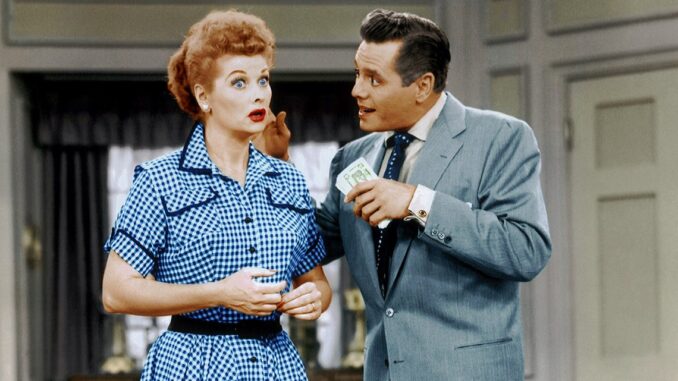
When you think of classic TV, I Love Lucy likely tops the list. This iconic sitcom, starring Lucille Ball and Desi Arnaz, remains a beloved treasure of television history. But behind the laughs and Lucy’s charming antics lie fascinating details and surprising facts that even the most dedicated fans may not know. Here, we dive deep into the hidden stories, off-screen secrets, and little-known aspects of I Love Lucy that bring new appreciation for this timeless series.
1. The Groundbreaking Multicam Setup Changed TV Forever
For the first time in television, I Love Lucy used a multi-camera setup to film a live audience sitcom. This innovative approach not only helped capture the show’s humor from multiple angles but also created a livelier atmosphere. The groundbreaking technique, pioneered by cinematographer Karl Freund, became a standard in the TV industry, shaping the sitcom landscape for decades.
2. Lucille Ball and Desi Arnaz Were the First Interracial TV Couple
I Love Lucy was not only about comedy; it was groundbreaking in other ways, too. Lucille Ball and Desi Arnaz made history as the first interracial couple on television. In an era when Hollywood often shied away from diverse casting, Ball and Arnaz’s real-life marriage translated to the screen, normalizing interracial relationships for a vast audience and setting a new precedent for inclusivity.
3. Lucille Ball’s Real Pregnancy Was Written Into the Show
In the conservative 1950s, showing a pregnancy on TV was nearly unheard of. But when Lucille Ball became pregnant in real life, the writers chose to make history by including her pregnancy in the storyline. It was a bold move, and even though the word “pregnant” couldn’t be used due to network restrictions, I Love Lucy handled it with charm, opening up new possibilities for realistic storytelling on TV.
4. The Chocolate Factory Scene Wasn’t as Sweet as It Looked
One of the most famous scenes in I Love Lucy features Lucy and Ethel struggling to keep up with a fast-moving chocolate conveyor belt. This iconic scene was hilariously chaotic, but what viewers may not know is that Lucille Ball wasn’t fond of chocolate! The intense setup and relentless speed of the belt made the scene challenging and exhausting, adding authenticity to Lucy’s comedic desperation.
5. Lucille Ball’s Influence Helped Shape Star Trek
Though it sounds surprising, I Love Lucy and Star Trek are connected. Desilu Productions, the company founded by Ball and Arnaz, eventually became the studio that greenlit Star Trek. Lucille Ball saw potential in Gene Roddenberry’s sci-fi concept and made the call to support the project, even when others doubted it. Without her faith in the show, Star Trek might never have hit the screen.
6. Desi Arnaz’s Business Genius Paved the Way for TV Syndication
Desi Arnaz wasn’t just a talented actor; he was also a savvy businessman. He negotiated a deal that allowed I Love Lucy to be filmed on 35mm film rather than live broadcast. This decision preserved the quality of the show, making it possible to re-air episodes in syndication, a concept that was new at the time. Thanks to Arnaz’s foresight, I Love Lucy became one of the most successful syndicated shows ever.
7. The Show Had to Use Clever Tricks for Budget Constraints
While I Love Lucy may seem high-quality, the show actually had a tight budget, and it often had to get creative to save costs. For example, the writers frequently recycled guest stars for multiple characters, changing minor details to make them appear different. Additionally, the show’s apartment set was cleverly repurposed for various scenes, helping the production team stretch their dollars while still delivering quality content.

8. Vivian Vance and William Frawley’s Real-Life Tension Added to Their On-Screen Chemistry
Though they portrayed close friends Fred and Ethel on-screen, Vivian Vance and William Frawley had a notoriously tense off-screen relationship. Frawley, older by several decades, was often irritated by Vance’s comments about their age difference, while Vance reportedly found Frawley’s attitude difficult. Their real-life dynamic added a unique spark to their interactions, making their comedic partnership even more compelling.
Conclusion
I Love Lucy remains a timeless show not just because of its humor but because of the real-life stories and innovative steps that brought it to life. Lucille Ball and Desi Arnaz’s influence stretched far beyond their roles, paving the way for future generations in television and setting standards that still impact the industry today. Each of these lesser-known facts adds depth to our appreciation of the show, proving that I Love Lucy will continue to charm audiences for years to come.
FAQs
1. How did I Love Lucy change television production?
The show’s multi-camera setup and live audience recording were innovative techniques that transformed how sitcoms were produced, becoming a standard in the industry.
2. Did Lucille Ball and Desi Arnaz create Desilu Productions?
Yes, they co-founded Desilu Productions, which went on to produce several iconic shows, including Star Trek.
3. Why was Lucille Ball’s pregnancy on the show groundbreaking?
At the time, it was unusual to show a pregnant woman on television, and I Love Lucy pushed boundaries by integrating Lucille’s real-life pregnancy into the storyline.
4. What was the real relationship like between Vivian Vance and William Frawley?
Despite their on-screen chemistry, Vance and Frawley reportedly didn’t get along well off-screen, adding an interesting layer to their interactions as Fred and Ethel.
5. How did Desi Arnaz influence TV syndication?
Arnaz’s decision to film I Love Lucy on 35mm film enabled syndication, which allowed the show to continue airing even after the series ended, making it a pioneer in TV syndication.
